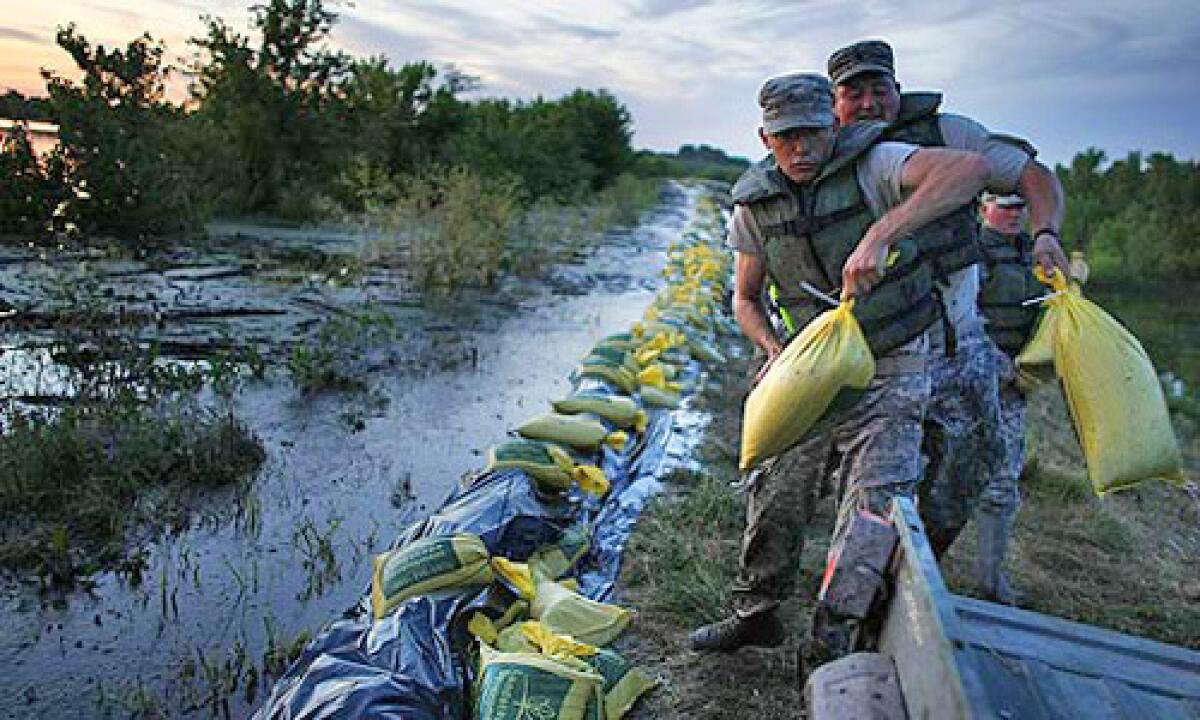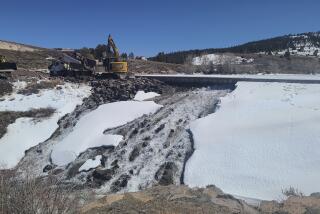As floodwaters recede in the Midwest, anger rises

After the great floods of 1993 swamped this tiny town in eastern Iowa, Mike Luck begged the U.S. Army Corps of Engineers to help protect it from future disasters.
Corps officials responded that this community of fewer than 700 residents probably would have to chip in more than $1 million to help build the federally engineered levee system it sought, the former mayor recalled.
Unable to raise the funds, New Hartford built an earthen berm, which breached recently when Beaver Creek flooded, part of the widespread flooding in six Midwestern states.
“There was no way we could get that kind of money pulled together for a levee,” Luck said. “It took this town more than three years of bake sales and barbecues to raise enough money for new playground equipment.
“It felt like the government was telling us, ‘You’re not big enough or important enough for us to spend our money to save,’ ” Luck said.
As the waters in the Midwest recede and an early tally of the region’s devastating floods reaches billions of dollars, some communities are blaming their woes on the federal government, saying it turned its back on their pleas for help building or bolstering the barriers protecting them from the Mississippi River and other waterways.
Federal rules require communities to help pay for projects that can cost millions, which can put them out of reach. In Iowa, where 71% of the 949 towns have populations of fewer than 1,000, those rules can be a forbidding obstacle.
So some Midwestern towns built their own flood protection, adding to an aging patchwork system of varying quality.
State officials in the Midwest say their budgets are too tight to create a uniform system for every waterway, and look enviously at California, which is spending $5 billion in bond money to double Sacramento’s flood protection over the next decade.
“That’s almost as much as our entire state budget,” said Richard Leopold, director of the Iowa Department of Natural Resources.
The agency oversees the state’s flood-plain management system, but relies on more than 130 local agencies to oversee the maintenance of the barriers. “We asked the state Legislature for $300,000 this year so we could do dam and levee inspections, and other flood issues, and we didn’t get a dime,” Leopold said.
Corps spokesman Gene Pawlik said part of the problem dates from the Reagan administration, which directed the corps to weigh the economic benefit against the cost of each project. Projects in these rural areas sometimes require an “investment so large, it may be determined not in the best federal interest to do anything.”
In some cases, local groups have raised the levels of their levees, only to be told by the corps, state officials, or both to drop them to their original height. Federal and state regulations can prohibit raising levee height because that can affect water levels in other drainage areas or downriver.
“It’s like getting a ticket from a policeman -- you try to talk him out of it, but you know, ‘the rules,’ ” said David Bleigh, president of the flood-threatened South River Drainage District, near Palmyra, Mo.
The district added two feet to its levees after the 1993 flood, Bleigh said, but the corps ordered them reduced back to their original 28-foot height.
The conflict reflects a grim calculus, said Doug Johnston, chairman of the community and regional planning department at Iowa State University: Some small communities may not be a good investment.
“Of course, it’s cold to have to tell that to the residents who’ve lived there for generations,” Johnston said.
Federal engineers reported in 2004 that although La Porte City, Iowa, had flooded “on at least 10 occasions over the past century,” there was no “economic justification” for a federal flood-protection project.
“We’ve been fighting this fight with the corps since 1993, and it’s always the same: The cost of building the protection has got to be at least worth the value of property it’s protecting in the long run,” said La Porte City Mayor Rick Lubben.
The town flooded again this year.
Iowa officials predict crop losses statewide will be at least $3 billion. In Cedar Rapids, the state’s second-largest city, more than 1,200 city blocks flooded. Leaders estimate that up to $1 billion will be needed.
The toll is a reminder of the lack of a unified system to fight floods on the upper Mississippi River, a step that a presidential task force recommended after the 1993 floods.
“The problem is nobody knows who’s in charge, and this is a problem you have up and down the Mississippi,” said Brig. Gen. Gerald Galloway, formerly with the Corps of Engineers, who led the task force.
After the 1993 report, Congress authorized the corps to study comprehensive flood-control plans for the upper Mississippi. That report said it would cost billions and would not be cost-effective.
But how the corps sets priorities for such projects may change, officials say. Congress has instructed the agency to reevaluate that process.
nicholas.riccardi @latimes.com
More to Read
Start your day right
Sign up for Essential California for news, features and recommendations from the L.A. Times and beyond in your inbox six days a week.
You may occasionally receive promotional content from the Los Angeles Times.





